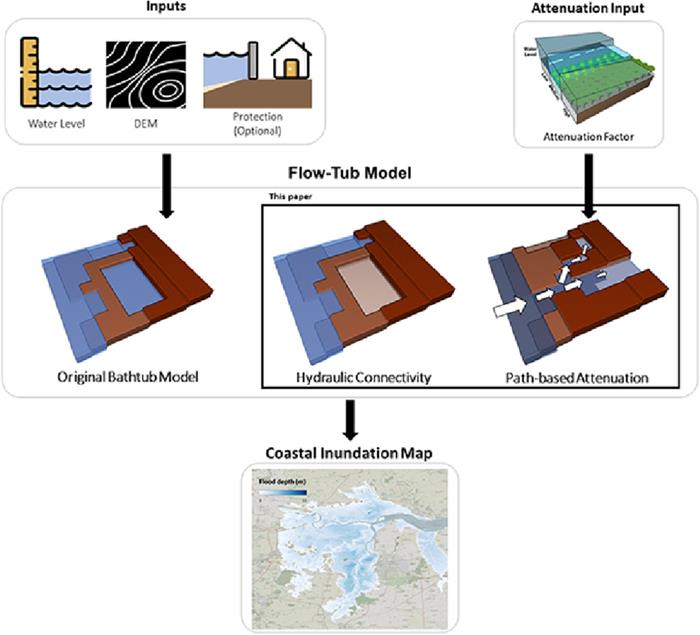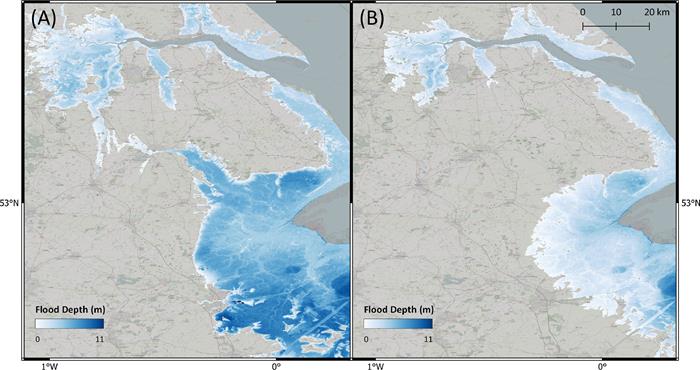Cities and coastlines face increasing risks of coastal storms because of global climate change and sea-level rise. These storms threaten to flood coastal areas, and to increase the frequency of disruption in areas already vulnerable to flooding. Flood maps that highlight the potential future extent and water depth at different locations have thus become valuable tools for risk management and urban planning.
But how to create a map that accurately represents flood risk from coastal storms that have never happened before? We need to consider many scenarios and a vast range of potential storms. And this requires a lot of computational power. To tackle this challenge, the Disaster Analytics for Society Lab (DASL) at the Earth Observatory of Singapore (EOS) developed a new model for mapping large-scale flood risk while maintaining accuracy and computational efficiency.
Called Flow-Tub, the model outputs coastal flood maps that project water depths globally between 2020 and 2100, for a number of climate change scenarios and a range of coastal storm return periods. The findings were recently published in MethodX. The model represents one of DASL’s core models and addresses some of the growing challenges associated with quantifying regional flood risk.

EOS Research Fellow Indraneel Kasmalkar working on the Flow-Tub algorithm (Source: DASL/Earth Observatory of Singapore)
Quantifying flood risk involves accurately estimating the flood extent and depth during a coastal storm. There are two approaches to estimate the flooded areas, each with its advantages and challenges.
Hydrodynamic models are the gold standard as they solve the fluid dynamics equations that capture the complexity of water movement. However, they are computationally intensive and may require unreasonably long run times for large coastlines. Moreover, projecting flood risk is a probabilistic endeavour: capturing the uncertainty of flooding requires simulating a broad range of synthetic flood events - tens of thousands of them. The computational intensity of hydrodynamic models makes it infeasible to simulate a large number of events.
A simpler approach is to use bathtub inundation models. Here, a water level is selected to represent the combined effect of a coastal storm and sea-level rise, and areas lower than that level are deemed as flooded. This method is computationally efficient, but it can mark areas as flooded even if the water might not physically be able to reach them. This can lead to significant false positives and an overestimation of the flood extent. Additionally, the method does not account for surface friction or for the limited durations of storms which are major factors that constrain the flood extents of storms.

Standard bathtub model. The cross indicates an area that the model represents as flooded because of its low elevation even though the area has no viable path of water flow from the coastline (Source: Figure 1 from the study published in MethodX)
The Flow-Tub model marries the computational efficiency of bathtub models with additional hydrodynamic processes related to surface friction and attenuation to improve the accuracy of the estimated flood depth and extent.

An overview of the inputs and features of the Flow-Tub model (Source: Graphical abstract from the study published in MethodX)
The Flow-Tub model starts by inundating low-lying areas at the coastline. It then assesses how the water level attenuates, and whether water can overcome local topography and protection measures to propagate into the neighbouring region further inland. If these conditions are met, the region is marked as flooded and the model repeats the process sequentially while moving inland.
Our findings show that Flow-Tub substantially improves upon the shortcomings of the bathtub model. For the example of Hull, United Kingdom, below, the bathtub model dramatically overestimates the extent of flooding compared to the Flow-Tub model which accounts for flow feasibility and attenuation. The Flow-Tub results would be similar to that from a hydrodynamic model, but Flow-Tub can run in a fraction of the time required by the hydrodynamic models and with reasonable accuracy. These various aspects make Flow-Tub a valuable tool for the projection of regional flood risk.

Floods maps for Hull, United Kingdom generated by (A) the standard bathtub model (left) and (B) the Flow-Tub model (right). The results demonstrate that connectivity and path-based attenuation reduce flood extents and volumes compared to standard bathtub models (Source: Figure 8 from the study published in MethodX)
With its balance of accuracy and computational feasibility, Flow-Tub can thus serve as a valuable tool for estimating the flood risk of large regions such as cities and countries. Furthermore, because it can account for various coastal protection measures, it could also be used to assess the effectiveness of mangroves or flood walls to protect our coasts from sea-level rise and storm surges. Overall, Flow-Tub enables to better project the impacts of extreme coastal flooding as we enter an era with expected higher sea levels and more intense storms.
This research was funded by the South-East Asia Sea-Level Rise Program (grant no. MOE 2019-T3-1-004) and by the National Research Foundation, Prime Minister's Office, Singapore under the NRF-NRFF2018-06 award.